 UPDATED REVIEW – June 1, 2024 – Yamaha Clavinova CLP-735, Yamaha CLP-745, Yamaha CLP-765GP Digital Pianos – | LOWER PRICE HERE on top brands.
UPDATED REVIEW – June 1, 2024 – Yamaha Clavinova CLP-735, Yamaha CLP-745, Yamaha CLP-765GP Digital Pianos – | LOWER PRICE HERE on top brands.The top 3 Clavinova digital pianos under $6000 include the CLP-735, CLP-745, and CLP-765GP. They all have some impressive improvements and upgrades beyond the previous CLP-600 series and definitely are impressive in many ways. They still have have a few shared features with the previous series such as the LCD user interface, many of the instrument sounds, the recording features, and a few other useful things from the previous models. There are a few advancements from the previous series which certainly are nice, but the focus of these new CLP-700 models is that they are noticeably more authentic for piano sound, piano key action response, and the ability of the internal speaker systems to project that sound in a more natural way as compared to previous models.
That is really what piano playing is all about…getting the most authentic piano playing experience you can get within a specific price range. Plus, Yamaha has added a couple new cabinet colors to the mix (one for the US and a second one for the international market) which makes it even better for people looking for a more contemporary cabinet finish. So has Yamaha hit a “home run” with their improvements in these newer Clavinova models? Let’s take a look!
 The reason I am reviewing and comparing these 3 specific models together is because their price ranges are by far the most popular for the more advanced furniture cabinet model digital pianos. The CLP-735 is (was) $2899 in the matte finishes and $3399 in the polished ebony finish. The CLP-745 is $3799 in the matte finishes including black, rosewood, dark walnut, and the all new snow white. Yamaha also produces the CLP-735 and 745 in a new light “ash” color which you can see in the image above but that color is not available in the US but only available in other countries. The elegant polished ebony finish for the CLP-745 is priced at $4299 which is actually pretty reasonable for that upgraded cabinet finish.
The reason I am reviewing and comparing these 3 specific models together is because their price ranges are by far the most popular for the more advanced furniture cabinet model digital pianos. The CLP-735 is (was) $2899 in the matte finishes and $3399 in the polished ebony finish. The CLP-745 is $3799 in the matte finishes including black, rosewood, dark walnut, and the all new snow white. Yamaha also produces the CLP-735 and 745 in a new light “ash” color which you can see in the image above but that color is not available in the US but only available in other countries. The elegant polished ebony finish for the CLP-745 is priced at $4299 which is actually pretty reasonable for that upgraded cabinet finish. The CLP-700’s have some very nice improvements, as I mentioned, including some subtle cabinet design changes and upgrades over previous models such as more curved/beveled front legs and more rounded front keyboard panel, and they look great with their key covered closed up and a matching bench with them. So when it comes to a furniture cabinet digital piano in the price range of about $2900 to $6700, these new Yamaha Clavinova models are definitely some of the best out there right now.
The CLP-700’s have some very nice improvements, as I mentioned, including some subtle cabinet design changes and upgrades over previous models such as more curved/beveled front legs and more rounded front keyboard panel, and they look great with their key covered closed up and a matching bench with them. So when it comes to a furniture cabinet digital piano in the price range of about $2900 to $6700, these new Yamaha Clavinova models are definitely some of the best out there right now.YAMAHA KEY ACTION
 In digital pianos the key action and the the way it moves and responds to finger touch is considered to be the most important part of any digital piano and when you get into these prices ranges then it is even more important. In the previous CLP-600 models, the key actions were good and for most people enjoyable to play, but there were still a few drawbacks to them. When your fingers played towards the backs of the keys as opposed to playing more towards the fronts of the keys with your fingers on a digital piano, it typically takes more finger force to press down the keys. On a regular acoustic upright piano it is very similar and also takes more finger force to press down the keys towards the back of them (especially when playing flats & sharps) as compared with moving the fingers towards the tips of the keys.
In digital pianos the key action and the the way it moves and responds to finger touch is considered to be the most important part of any digital piano and when you get into these prices ranges then it is even more important. In the previous CLP-600 models, the key actions were good and for most people enjoyable to play, but there were still a few drawbacks to them. When your fingers played towards the backs of the keys as opposed to playing more towards the fronts of the keys with your fingers on a digital piano, it typically takes more finger force to press down the keys. On a regular acoustic upright piano it is very similar and also takes more finger force to press down the keys towards the back of them (especially when playing flats & sharps) as compared with moving the fingers towards the tips of the keys. That’s one of the reasons why you’ll rarely see an advanced or accomplished piano player wanting to play on an acoustic upright piano as compared to a grand piano…because upright key actions can throw off your playing technique a bit because those keys are more somewhat unbalanced as compared to a grand piano with much longer keys.
That’s one of the reasons why you’ll rarely see an advanced or accomplished piano player wanting to play on an acoustic upright piano as compared to a grand piano…because upright key actions can throw off your playing technique a bit because those keys are more somewhat unbalanced as compared to a grand piano with much longer keys.On acoustic grand pianos the keys are not only much longer but they move differently than on an acoustic upright piano so the goal of any good piano player and aspiring pianist is to eventually play their music on a grand piano because it can make a big difference in the outcome of their music.
 The key action movement has been redesigned on the CLP-735, CLP-745, and CLP-765GP so that the keys will be more balanced and move more smoothly and quickly with less difference in front to back of key balance than on prior models from the CLP-600 series. This key action change (called the Grand Touch-S (with escapement) helps beginner through advanced piano players be able to play their music more evenly and naturally with a better musical outcome…and that is a very good thing.
The key action movement has been redesigned on the CLP-735, CLP-745, and CLP-765GP so that the keys will be more balanced and move more smoothly and quickly with less difference in front to back of key balance than on prior models from the CLP-600 series. This key action change (called the Grand Touch-S (with escapement) helps beginner through advanced piano players be able to play their music more evenly and naturally with a better musical outcome…and that is a very good thing. “marketing” terminology in trying to promote these new pianos as the “perfect” digital pianos…and although they are not perfect….the upgrades to the key action are very noticeable when it comes to replicating the playing experience of a real acoustic piano.
“marketing” terminology in trying to promote these new pianos as the “perfect” digital pianos…and although they are not perfect….the upgrades to the key action are very noticeable when it comes to replicating the playing experience of a real acoustic piano. The CLP-735 and CLP-765GP mini grand have the same key actions as each other and they are made of plastic like many other brands in this price range…and that’s fine as long as those graded and piano weighted plastic key actions respond well, move properly, and be comfortable without playability issues…and in this case I was very pleased with this key action.
The CLP-735 and CLP-765GP mini grand have the same key actions as each other and they are made of plastic like many other brands in this price range…and that’s fine as long as those graded and piano weighted plastic key actions respond well, move properly, and be comfortable without playability issues…and in this case I was very pleased with this key action.
 Please be aware there is a website blog out there which says that the CLP-735 key action has wooden keys. It does not have wooden keys (neither white or black) and obviously this site does not know what they are talking about when it comes to this instrument.The CLP-745 has wooden content white keys but not black keys. If you want to know who the site is then ask me. It is sad that there are so many “so-called” reviewers on-line that pretend to know what they are talking about but they don’t because they don’t really play the piano and don’t actually know much about digital pianos.
Please be aware there is a website blog out there which says that the CLP-735 key action has wooden keys. It does not have wooden keys (neither white or black) and obviously this site does not know what they are talking about when it comes to this instrument.The CLP-745 has wooden content white keys but not black keys. If you want to know who the site is then ask me. It is sad that there are so many “so-called” reviewers on-line that pretend to know what they are talking about but they don’t because they don’t really play the piano and don’t actually know much about digital pianos. The key top material being used in the new models is the newer synthetic ivory and synthetic ebony to give the keys a more “tactile feeling” when playing them and a classier look as well. They feel great and also help absorb sweat from the fingers. Escapement is a term used to signify the noticeable hesitation or physical “bump” or notch that is felt when you press down the key lightly on a grand piano right before the keys hits bottom. This “escapement” (aka: letoff) feeling allows the player to feel where they are in the key travel as you press down the key towards the bottom and this function/feature is normally only felt on a grand piano as opposed to an upright piano. Yamaha has had this feature before on their previous models but in reality it was a poor representation of the real thing and I did not like it and said so in my reviews of those models.
The key top material being used in the new models is the newer synthetic ivory and synthetic ebony to give the keys a more “tactile feeling” when playing them and a classier look as well. They feel great and also help absorb sweat from the fingers. Escapement is a term used to signify the noticeable hesitation or physical “bump” or notch that is felt when you press down the key lightly on a grand piano right before the keys hits bottom. This “escapement” (aka: letoff) feeling allows the player to feel where they are in the key travel as you press down the key towards the bottom and this function/feature is normally only felt on a grand piano as opposed to an upright piano. Yamaha has had this feature before on their previous models but in reality it was a poor representation of the real thing and I did not like it and said so in my reviews of those models.
Quieter key movement, better escapement feature, more evenly balanced keys with quicker down-weight and up-weight from front to back and side to side, and just a better overall design. Nice job, Yamaha…it’s about time. Take a look below at the CLP-745 key action in the video below as it is moving from within the piano. This is a video view from behind the white keys. You can hear some key movement noise when the keys are going up and down in this video but this noise is not heard at all when the piano is closed up and the keys are being played in a normal way.
PIANO SOUND SAMPLES
 The piano sounds consist of 2 separate piano reproductions just like on the previous models which includes a Yamaha concert grand piano from Japan called the CFX and a European Bosendorfer Grand piano from Vienna, Austria. These 2 piano sound reproductions are done with a combination of Sampling and Physical Modeling technology to create a better and more natural piano sound with more nuanced expression. These 2 world famous grand piano sounds were in the previous models but have been improved even further to sound noticeably more natural and organic than in the previous models. Yamaha did not change their overall approach to the piano sounds they have chosen in these models but they did use newer and better technology to capture those piano sounds in a more organic way. The polyphony ability of the pianos is the same as before at 256-note maximum polyphony power which is more than enough for most musical applications and playing styles.
The piano sounds consist of 2 separate piano reproductions just like on the previous models which includes a Yamaha concert grand piano from Japan called the CFX and a European Bosendorfer Grand piano from Vienna, Austria. These 2 piano sound reproductions are done with a combination of Sampling and Physical Modeling technology to create a better and more natural piano sound with more nuanced expression. These 2 world famous grand piano sounds were in the previous models but have been improved even further to sound noticeably more natural and organic than in the previous models. Yamaha did not change their overall approach to the piano sounds they have chosen in these models but they did use newer and better technology to capture those piano sounds in a more organic way. The polyphony ability of the pianos is the same as before at 256-note maximum polyphony power which is more than enough for most musical applications and playing styles.
Yamaha also added 2 completely new acoustic pianos to the sound library which includes what are known as “historical” acoustic pianos which would have been the actual pianos that Beethoven Mozart, and others would have played while they were alive centuries ago. Those pianos were not constructed in a way pianos are today and therefore had a distinctly different sound, moire percussive, brighter, and even a big twangy. The 2 historical pianos that Yamaha actually sampled/recorded and put into the new 700 series pianos include the Mozart grand piano and the Chopin grand piano.
 The difference between the 2 of them is that the Mozart piano sound is deeper and even sounds a bit like a harpsichord with some twangy-metallic tone to it whereas the Chopin piano sound is lighter, and more delicate. So when you hear a Mozart piece of music played on a current model acoustic grand piano today, it is not what Mozart would have experienced in his day and the same is true for Chopin, the famous composer-pianist. So Yamaha added 2 of these “period” pianos to give the you the feeling of what a piano was like to hear in those days. Key action was also different on those historical pianos but in digital pianos that feeling cannot be reproduced because of the proprietary mechanics in the key actions of those old pianos. Nevertheless, it’s great for those piano players interested in recreating a historical sound environment when playing that type of music.
The difference between the 2 of them is that the Mozart piano sound is deeper and even sounds a bit like a harpsichord with some twangy-metallic tone to it whereas the Chopin piano sound is lighter, and more delicate. So when you hear a Mozart piece of music played on a current model acoustic grand piano today, it is not what Mozart would have experienced in his day and the same is true for Chopin, the famous composer-pianist. So Yamaha added 2 of these “period” pianos to give the you the feeling of what a piano was like to hear in those days. Key action was also different on those historical pianos but in digital pianos that feeling cannot be reproduced because of the proprietary mechanics in the key actions of those old pianos. Nevertheless, it’s great for those piano players interested in recreating a historical sound environment when playing that type of music.
BINAURAL HEADPHONE EXPERIENCE
 When listening to these pianos through stereo headphones it’s certainly good to get the best stereo sound reproduction you can get in your ears so that it will sound like a full grand piano in your head! Yamaha has a special “circuit” or technology that is called Binaural Sampling and this technology is a separate feature which give both acoustic pianos sounds (Yamaha & Bosendorfer) extra added realism when listening through a good pair of stereo headphones. In the previous models this technology was only available for the Yamaha grand piano sound. But in the new 700 series it also applies to the Bosendorfer grand piano sound. In fact, I was very disappointed that this technology was not available in the previous models for the Bosendorfer piano sound and I mentioned it in my previous review of those models.
When listening to these pianos through stereo headphones it’s certainly good to get the best stereo sound reproduction you can get in your ears so that it will sound like a full grand piano in your head! Yamaha has a special “circuit” or technology that is called Binaural Sampling and this technology is a separate feature which give both acoustic pianos sounds (Yamaha & Bosendorfer) extra added realism when listening through a good pair of stereo headphones. In the previous models this technology was only available for the Yamaha grand piano sound. But in the new 700 series it also applies to the Bosendorfer grand piano sound. In fact, I was very disappointed that this technology was not available in the previous models for the Bosendorfer piano sound and I mentioned it in my previous review of those models.But I am happy to say that Yamaha “listened to me” and included to Binaural sampling technology in these new pianos so that the headphone listening experience has been greatly improved when using the European grand piano sound. This does not change how that sound is head through the internal speakers…only through stereo headphones. It’s just a fuller, richer, and more vibrant sound and for people who want to use headphones for private practice, you will appreciate this upgrade very much.
INTERNAL SPEAKER SYSTEM
 On the previous CLP-600 series models the internal speaker systems were good, but they were still a bit weak, especially the CLP-635 at just 60 watts of total power going through 2 amplifiers and 2 speakers. On the 3 new 700 series models the internal speaker power has been improved except for the CLP-735 which remains the same as in the previous CLP-635. Even though you can get the CLP-735 to be loud enough, it just does not sound as rich and bassy as I would have liked to see. For $2899 I think they could have done better in terms of audio power, but it is still good…just not where it should be in my opinion. However, on the new CLP-745 Yamaha did upgrade that internal speaker system in a big way going from 100 watts of total power to 200 watts of total power with 4 amplifiers and 4 speakers. The CLP-745 now has the kind of sound and headroom it should have in this price range.
On the previous CLP-600 series models the internal speaker systems were good, but they were still a bit weak, especially the CLP-635 at just 60 watts of total power going through 2 amplifiers and 2 speakers. On the 3 new 700 series models the internal speaker power has been improved except for the CLP-735 which remains the same as in the previous CLP-635. Even though you can get the CLP-735 to be loud enough, it just does not sound as rich and bassy as I would have liked to see. For $2899 I think they could have done better in terms of audio power, but it is still good…just not where it should be in my opinion. However, on the new CLP-745 Yamaha did upgrade that internal speaker system in a big way going from 100 watts of total power to 200 watts of total power with 4 amplifiers and 4 speakers. The CLP-745 now has the kind of sound and headroom it should have in this price range.
 The CLP-735 does not have these 2 additional speakers and so the CLP-745 sounds much better and is more realistic than the CLP-735. So Yamaha has really done a very good job here in improving the quality and fullness of sound you get out of these new instruments, with the exception of the CLP-735 which remains the same as before in the previous CLP-635. CLP-745 upper speakers (there are 2 of them) are also each mounted separately inside enclosed speaker boxes which gives provides those extra speakers more bass response and more “punch” and it really helps that big sound come out in a very noticeable way, just like on real acoustic pianos. With Yamaha’s experience building home and prop audio products it makes sense that they would utilize these ingenious designs to further enhance the piano playing experience.
The CLP-735 does not have these 2 additional speakers and so the CLP-745 sounds much better and is more realistic than the CLP-735. So Yamaha has really done a very good job here in improving the quality and fullness of sound you get out of these new instruments, with the exception of the CLP-735 which remains the same as before in the previous CLP-635. CLP-745 upper speakers (there are 2 of them) are also each mounted separately inside enclosed speaker boxes which gives provides those extra speakers more bass response and more “punch” and it really helps that big sound come out in a very noticeable way, just like on real acoustic pianos. With Yamaha’s experience building home and prop audio products it makes sense that they would utilize these ingenious designs to further enhance the piano playing experience.So given you have a new, more balanced key action with wooden white keys and a heftier speaker system, in my opinion the CLP-745 model is worth the difference in price over the CLP-735, plus…it has a few other feature upgrades over the CLP-735 that I will mention later. But…it is $800 more than the CLP-735 so there would be a hefty price jump to get into the CLP-745 over the CLP-735. The CLP-765GP mini grand piano speaker system has also been upgraded over the previous model and has gone from just 70 watts of total power in the previous CLP-665GP to a huge 184 watts of total power going into 4 amplifiers and 4 speakers.
This is a big improvement and really gives this digital “grand piano” the kind of volume, power, and tone it needs to feel like it is really putting out sound worthy of this type of instrument. The speakers and their positioning inside the piano have also been improved and upgraded. With this new CLP-765GP mini grand model being in the same price as the previous CLP-665GP, it’s a no-brainer when it come to buying it…and this time it’s definitely worth it and you won’t be disappointed in this price range.
PEDALS
 To play the sustain pedal correctly takes time and practice but once you have learned out to do it properly you cannot live without it when it comes to playing beautiful music. To get a quality sustained piano tone, not only do you need to have the right pedaling technique, but the instrument needs to have a large piano tonal range with natural string vibrations, resonances, and overtones that can be easily heard as the piano sound is being sustained over time. That piano tone can either sound simple and plain or it can sound colorful and complex because of all the natural organic elements being heard while that piano sound is being sustained over time and decaying naturally as that sound fades out.
To play the sustain pedal correctly takes time and practice but once you have learned out to do it properly you cannot live without it when it comes to playing beautiful music. To get a quality sustained piano tone, not only do you need to have the right pedaling technique, but the instrument needs to have a large piano tonal range with natural string vibrations, resonances, and overtones that can be easily heard as the piano sound is being sustained over time. That piano tone can either sound simple and plain or it can sound colorful and complex because of all the natural organic elements being heard while that piano sound is being sustained over time and decaying naturally as that sound fades out.REAL GRAND EXPRESSION
 With this being said, Yamaha uses a newer technology (physical modeling) which Yamaha called “Grand Expression” and it helps to reproduce those complex natural organic piano tones that are normally reserved for real acoustic grand pianos. It’s all that natural detail of harmonics and resonances which occur in “real-time” on a real piano that Yamaha has reproduced in a convincing way on its new CLP-735, CLP-745, and CLP-765GP. In other words this new resonating technology is in all 3 of these new models whether you are hearing the piano through its internal speakers or listening through headphones. It’s very impressive and makes the piano sound more realistic than ever before. Is it exactly the same as a real grand piano…no, but it comes close. It will fool most people, especially those who do not have lots of playing experience on real high quality grand pianos…and that’s most people. This Grand Expression technology is effective whether you are playing fast, slow, hard, soft, using sustain pedal, or playing more staccato.
With this being said, Yamaha uses a newer technology (physical modeling) which Yamaha called “Grand Expression” and it helps to reproduce those complex natural organic piano tones that are normally reserved for real acoustic grand pianos. It’s all that natural detail of harmonics and resonances which occur in “real-time” on a real piano that Yamaha has reproduced in a convincing way on its new CLP-735, CLP-745, and CLP-765GP. In other words this new resonating technology is in all 3 of these new models whether you are hearing the piano through its internal speakers or listening through headphones. It’s very impressive and makes the piano sound more realistic than ever before. Is it exactly the same as a real grand piano…no, but it comes close. It will fool most people, especially those who do not have lots of playing experience on real high quality grand pianos…and that’s most people. This Grand Expression technology is effective whether you are playing fast, slow, hard, soft, using sustain pedal, or playing more staccato.But the beautiful resonate tone is especially noticeable when sustaining multiple notes at the same time. The other 2 pedals, soft and sostentuto, work well and do a good job for people who will be using those functions. If you are a beginner or even intermediate player you may never or seldom use either of those other 2 pedals. But for some people they will use one or both of them so they do function well for those purposes.
RHYTHM & TIMING FUNCTIONS

BLUETOOTH WIRELESS
 The CLP-745 and CLP765GP have Bluetooth audio wireless connectivity like they did on the previous models. However, they now include Bluetooth wireless “MIDI” connectivity which allows you to connect a computer or tablet (iPad) or other external device without the need of a USB/MIDI cable so that you can use computer music software or apps and not have to worry about connecting cables anymore which makes for a “cleaner look” on the piano too. Unfortunately, the CLP-735 does not have any Bluetooth technology so that’s another advantage of the CLP-745 along with the CLP-765GP mini grand. These are definitely features worth having because you can also wirelessly stream live recorded music through the piano speakers systems and play along live with that music. It makes for a lot of fun and allows to interact with your favorite songs and you can even do that using headphones while practicing in privacy.
The CLP-745 and CLP765GP have Bluetooth audio wireless connectivity like they did on the previous models. However, they now include Bluetooth wireless “MIDI” connectivity which allows you to connect a computer or tablet (iPad) or other external device without the need of a USB/MIDI cable so that you can use computer music software or apps and not have to worry about connecting cables anymore which makes for a “cleaner look” on the piano too. Unfortunately, the CLP-735 does not have any Bluetooth technology so that’s another advantage of the CLP-745 along with the CLP-765GP mini grand. These are definitely features worth having because you can also wirelessly stream live recorded music through the piano speakers systems and play along live with that music. It makes for a lot of fun and allows to interact with your favorite songs and you can even do that using headphones while practicing in privacy.USER INTERFACE & EXTRA FEATURES
 There are many features which these new pianos have which were also in the previous models because they are “standard” Yamaha features which really round out these models. These functions and features are accessed by Yamaha’s user interface with buttons that are fairly easy to use although they definitely take a bit of time to get used to them and learn the navigation of those functions. These extra built-in features include special effects (reverb, chorus, etc), wav file audio recording with USB flash drive slot for playing and saving your recorded music and giving it the “live recorded sound that you would hear if playing a CD recording, a 16-track MIDI recorder so that you can compose and arrange music using up to 16 separate instrument sounds played and recorded one at a time and then played back simultaneously (fun!).
There are many features which these new pianos have which were also in the previous models because they are “standard” Yamaha features which really round out these models. These functions and features are accessed by Yamaha’s user interface with buttons that are fairly easy to use although they definitely take a bit of time to get used to them and learn the navigation of those functions. These extra built-in features include special effects (reverb, chorus, etc), wav file audio recording with USB flash drive slot for playing and saving your recorded music and giving it the “live recorded sound that you would hear if playing a CD recording, a 16-track MIDI recorder so that you can compose and arrange music using up to 16 separate instrument sounds played and recorded one at a time and then played back simultaneously (fun!).
When you transpose you can quickly go up and down by 1/2 steps to any key you want without changing finger or hand positions. This feature allows the player to play the music as it is written but to also allow the song to be played in a different key so that any vocalist can sing along in a comfortable key for their voice. It also enables you to modulate the song and play it over again in a higher (or lower) key to give the piece of music more “drama” and excitement. There are many great features like this in the new CLP-700 series digital pianos.
YAMAHA SMART PIANIST APP
Another very cool thing this app does is that you can “import” your own iTunes into the app and play along with them and the app can instantly convert that song to a progressive chord chart so that you can see the actual accompaniment chords to the songs you are playing from your iTunes play list…it’s pretty amazing and it works.These are just a few of the things this impressive Yamaha app does but there are even more cool features within the app that are useful as well. Selecting the piano sound you want, the instrument sound you want, setting up a sound layer or sound split, using the recording function, changing the editing features, whatever it is you can do it easily and quickly with this Smart Pianist app and I cannot overstate how much fun it is to use…and all you need is an iPad which many people have these days.
EXTERNAL AND INTERNAL CONNECTIVITY
 This small red dot was pretty bright and when it was off it was fineexcept for the fact that it was a noticeable plastic raised dot on the front of the piano just below the keys on the left side and real pianos don’t, of course, have electric power. So to further give this cabinet a more natural design, Yamaha took off the indicator red power dot from the front of the piano and resigned the actual power button so that the light indicator was coming directly from the power button itself which is recessed in the top right side of the piano just above the master volume control slider. It’s a small thing to do but it does add to the organic nature of the cabinet so that the front panel under the keyboard is clean and smooth with no noticeable digital elements such as little power light in it. Even in this way the piano has been further made to look like a piano.
This small red dot was pretty bright and when it was off it was fineexcept for the fact that it was a noticeable plastic raised dot on the front of the piano just below the keys on the left side and real pianos don’t, of course, have electric power. So to further give this cabinet a more natural design, Yamaha took off the indicator red power dot from the front of the piano and resigned the actual power button so that the light indicator was coming directly from the power button itself which is recessed in the top right side of the piano just above the master volume control slider. It’s a small thing to do but it does add to the organic nature of the cabinet so that the front panel under the keyboard is clean and smooth with no noticeable digital elements such as little power light in it. Even in this way the piano has been further made to look like a piano.CABINET DESIGN & COLORS
 The piano cabinets on all 3 models are very attractive, and for the 2 upright models CLP-735 and CLP-745 they are available in matte black, matte rosewood, matte white, matte dark walnut, and for more money the polished ebony finish is also available in the CLP-735 and 745. The CLP-765GP mini grand piano is available by default in polished polyester finishes although the polished white finish in the CLP-765GP is considerably more money than the polished ebony finish. The cabinets are well built, have a sliding key cover, nicely positioned music rack with built-in music clips to hold the music, and a matching bench comes with each model. The matte white cabinet color in the CLP-735 and CLP-745 is a brand new cabinet color for Yamaha this year. The matte white color has not been available in past models but because of a trend lately for lighter colors including white, Yamaha decided to include it in this new series here is the US.
The piano cabinets on all 3 models are very attractive, and for the 2 upright models CLP-735 and CLP-745 they are available in matte black, matte rosewood, matte white, matte dark walnut, and for more money the polished ebony finish is also available in the CLP-735 and 745. The CLP-765GP mini grand piano is available by default in polished polyester finishes although the polished white finish in the CLP-765GP is considerably more money than the polished ebony finish. The cabinets are well built, have a sliding key cover, nicely positioned music rack with built-in music clips to hold the music, and a matching bench comes with each model. The matte white cabinet color in the CLP-735 and CLP-745 is a brand new cabinet color for Yamaha this year. The matte white color has not been available in past models but because of a trend lately for lighter colors including white, Yamaha decided to include it in this new series here is the US.FACTORY WARRANTY
The Yamaha factory warranty is 5 years parts & labor against any factory defects with in-home service which is a very good warranty. Yamaha products over the years have been very reliable and I have personally owned many Yamaha music products including acoustic and digital pianos, keyboards, guitars, band instruments, recording gear and lots of other Yamaha stuff. I just happen to like their products and they have been reliable for me for many years. I do like other brands and models of digital pianos including Kawai, Casio, Korg, and a few others but when it comes to cutting edge technology and a great piano playing experienced all contained in an attractive cabinet, it’s really difficult to beat Yamaha for what they are offering now in these new models.
FINAL THOUGHTS AND AVAILABILITY
 The bottom line is…these models are definitely improved in a few important ways over the older ones. It seems that more and more people are wanting to get a quality digital piano for their homes lately so they and/or their kids can be involved in music with learning to play piano or just having a great outlet to relax and escape with being able to play piano on a great instrument. Before you buy any brand and model of digital piano from anyone anywhere, please contact us first because we can share some vital info with you on how to buy for even less money for brand new digital pianos including free shipping, no tax, factory warranty, and more!
The bottom line is…these models are definitely improved in a few important ways over the older ones. It seems that more and more people are wanting to get a quality digital piano for their homes lately so they and/or their kids can be involved in music with learning to play piano or just having a great outlet to relax and escape with being able to play piano on a great instrument. Before you buy any brand and model of digital piano from anyone anywhere, please contact us first because we can share some vital info with you on how to buy for even less money for brand new digital pianos including free shipping, no tax, factory warranty, and more! 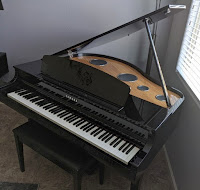 By the way, Yamaha produces 3 upper price range Clavinova CLP digital pianos for home and a variety of venues and those models are called CLP-775, CLP-785, and CLP-795 which go up to around $7500.These 3 models are also impressive and a great for people who have the extra disposable income and want the best CLP Clavinova they can get which offers an even more authentic piano playing experience along with many more “bells & whistles” in the top 2 models. Take a look at my review of these top of the line Clavinova CLP digital pianos at the following link and learn more about them: Yamaha CLP-775, CLP-785, CLP-795 Review
By the way, Yamaha produces 3 upper price range Clavinova CLP digital pianos for home and a variety of venues and those models are called CLP-775, CLP-785, and CLP-795 which go up to around $7500.These 3 models are also impressive and a great for people who have the extra disposable income and want the best CLP Clavinova they can get which offers an even more authentic piano playing experience along with many more “bells & whistles” in the top 2 models. Take a look at my review of these top of the line Clavinova CLP digital pianos at the following link and learn more about them: Yamaha CLP-775, CLP-785, CLP-795 Review– AN IMPRESSIVE DIGITAL PIANO OPTION –
CASIO-BECHSTEIN GRAND HYBRID GP-310 & GP-510
 |
A great alternative option for a high quality digital piano in my opinion is the newer Casio Grand Hybrid GP-310 and GP-510 – When you are considering a new digital piano and looking in the approx $4000 to $6000 price range and higher, in my opinion it’s always good to weigh your options and do your homework when you are in this higher price range. One of those digital piano options that is definitely worth consideration is one you may not know about and it is called the Casio-Bechstein Grand Hybrid GP-310 at $4299. This unique and impressive digital piano is produced by the Casio digital piano company of Japan in conjunction with the Bechstein Grand Piano company of Germany.
 Casio is famous for many years in producing digital technology products (as everyone knows) including very popular digital pianos. Bechstein Grand piano company is an internationally known European acoustic piano company producing handmade acoustic grand pianos for over 150 years. Casio went into a joint venture with Bechstein and produced a new digital piano with actual Bechstein all wood, extra length grand piano keys for both black and white keys combined with a new moving hammer system made of resin instead of wood (for a longer life) to simulate the counter-weight movement of real hammers.
Casio is famous for many years in producing digital technology products (as everyone knows) including very popular digital pianos. Bechstein Grand piano company is an internationally known European acoustic piano company producing handmade acoustic grand pianos for over 150 years. Casio went into a joint venture with Bechstein and produced a new digital piano with actual Bechstein all wood, extra length grand piano keys for both black and white keys combined with a new moving hammer system made of resin instead of wood (for a longer life) to simulate the counter-weight movement of real hammers.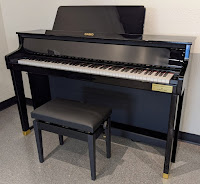 I have played these pianos and they are impressive when it comes to the “piano playing experience.” They are available in both matte black and matte white with matching height adjustable bench. There is also another higher priced model called the GP-510 at $6299 which is very impressive, but it is the GP-310 I am focusing on here especially as compared to the Yamaha CLP-745. Please read about this new piano in my review at the following link and let me know what you think: Casio GP-310/GP-510 Review.
I have played these pianos and they are impressive when it comes to the “piano playing experience.” They are available in both matte black and matte white with matching height adjustable bench. There is also another higher priced model called the GP-510 at $6299 which is very impressive, but it is the GP-310 I am focusing on here especially as compared to the Yamaha CLP-745. Please read about this new piano in my review at the following link and let me know what you think: Casio GP-310/GP-510 Review.If you want more info on new digital pianos and LOWER PRICES than internet discounts, please email me at tim@azpianowholesale.comor call direct at 602-571-1864.
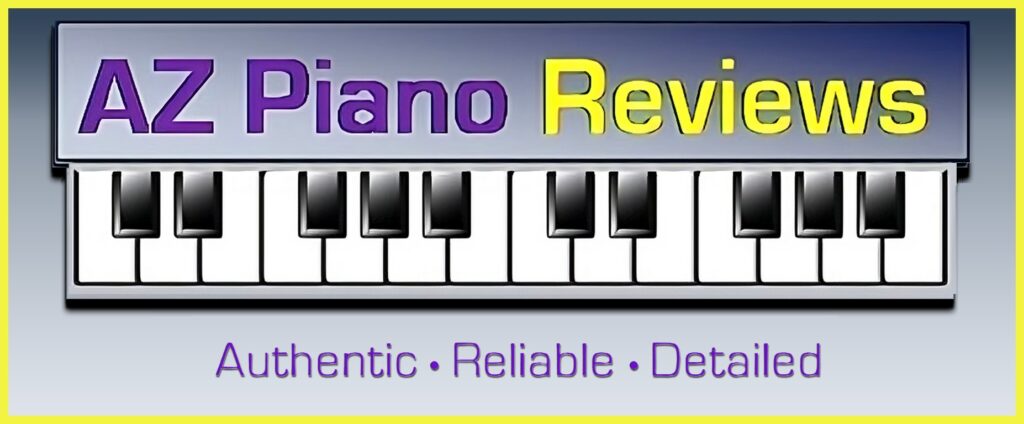











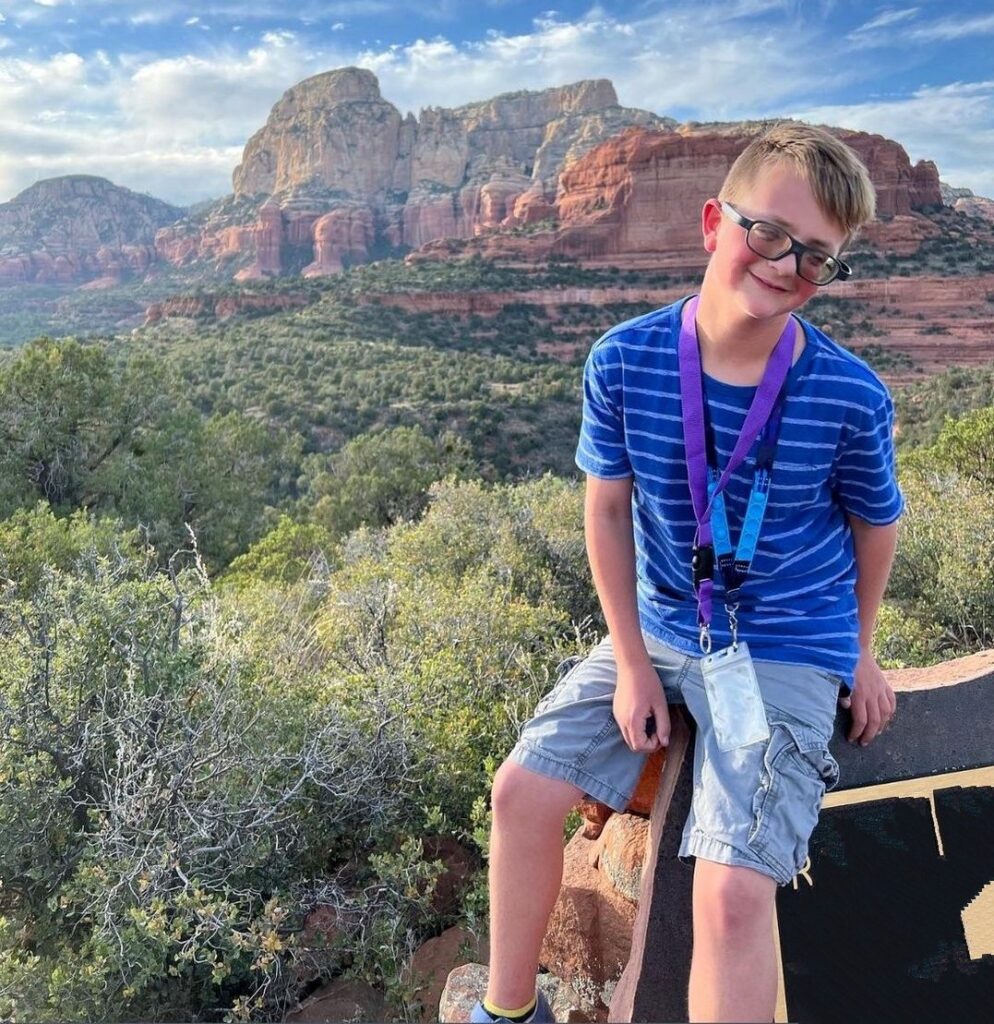
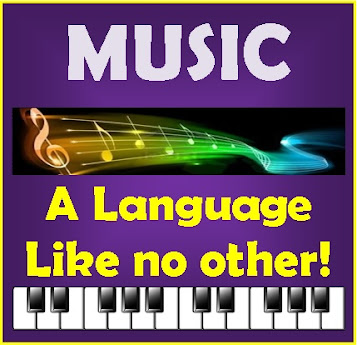
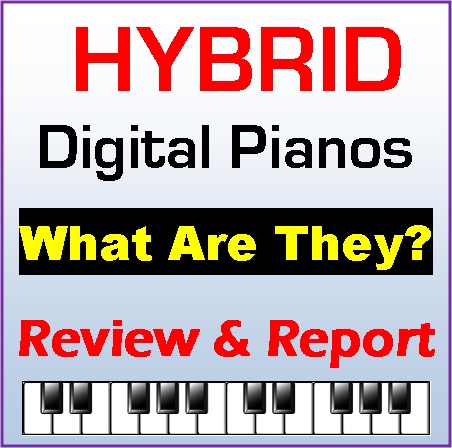
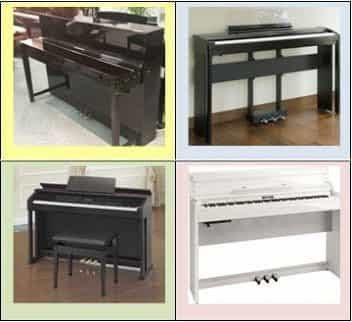
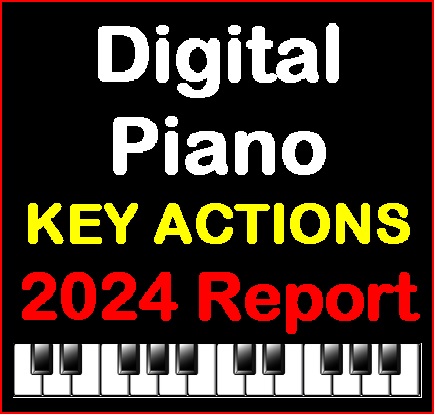
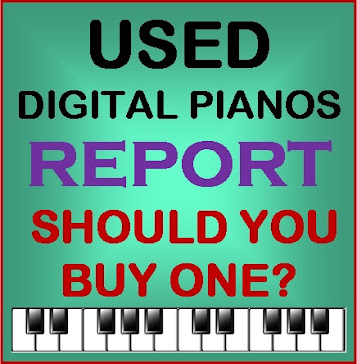
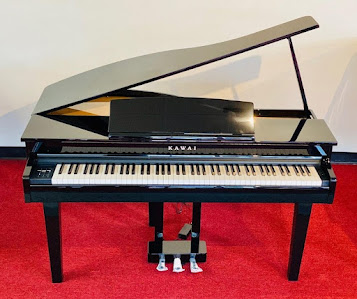
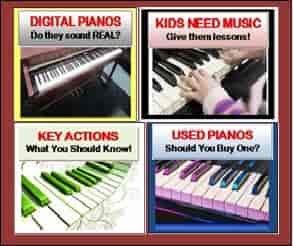
Nice!
I would like to see a 775/785/795 review!!
Hi,
Since the Grandtouch-S action is quite new, could you let us know how it feels to play? In particular:
– does the weighting feel appropriate? (not too heavy)
– do the graded key weights feel natural or artificial / blocky?
– do you easily prefer the action on the 745 versus the 645 (the latter seemed pretty good already), or is it more of a toss-up?
I already mentioned my findings about the key action in my review. If you read this review then you will get your answers
working on it now
I'm considering buying the 795 in white. Can you talk a bit about the finishes as they relate to staying clean, what shows when dinged by accident, etc. I'm really asking if someone maintains general cleaning and also if I use a piano cover, will it actually stay beautifully white? I know this might be a difficult question to answer without owning one for awhile, but do you have any reason to believe the black keeps its luster any longer than the white model would? Thanks ~Joey
I read on other forum that the 735 and 745 have plastic vs wood key and the key weight is different. Can you please tell us if it's true?
My 745 arrived last week after a six month wait (COVID-19 related delay?) and I love it, with one exception.
All the marketing material and even this review refer to Bluetooth audio. Caveat emptor, this does not mean you can use Bluetooth headphones. You cannot me need those pesky wires tangling in your arms while you play.
For all the bluster about Bluetooth I would much rather have the iPad connect by wires (and maybe keep charge too) than have it sitting pretty on the music stand while I wallow in wires.
A shame as wireless headphones are so mature – and yet this simple feature directly adjacent to other Bluetooth functions is missing.
Mark, the "caveat" with not including current Bluetooth headphone technology on a digital piano is the problem with "latency" or delay. When streaming pre-recorded music via Bluetooth wireless audio through Bluetooth speakers, "latency" or delay is irrelevant. You hear the music when you hear it and it is independent of anything else so you do not notice any problems. With a digital piano, if you had Bluetooth wireless headphones and the piano could stream to those headphones, when you play piano notes on the Yamaha (or any other brand) you would not hear those notes in your Bluetooth headphones until a fraction of a second later after striking the keys on the piano. In other words, there would be a slight delay between the time you played a note (or notes) on the piano until the time you actually heard those notes in the Bluetooth wireless headphones. Imagine that situation between what your fingers are doing and what (and when) your ears are hearing! It's a noticeable delay that will throw you off musically speaking. That is why digital piano manufacturers (all of them) are not using Bluetooth for headphone output…because it cannot keep up with your fingers playing in real time. So in reality you are benefitting from not having a Bluetooth headphone connection because otherwise it would drive you "musically crazy" if you did have it. Someday when the "latency" issue is resolved with future wireless technology then we will see wireless headphone technology in digital pianos…but not until then. Enjoy using a good set of wired stereo headphones. You can count on them to work well and deliver the sound as intended and expected.
yes, this is true
hey, I am from India. I have been doing RnD since 3 weeks now to get the best DP for myself. I have brought it down to CLP735 and CA49. CLP 745 is not available anywhere in India. I am used to playing Clavinova but as you and other experts suggested Kawai has a better action. I haven't personally played any Kawai DP before. What would u suggest out of the two?
Fantastic review on CLP-745 at a much needed time. Thank you. I decided to buy it before reading your review, and I am even more excited now. Also, you explained each feature in good detail. Being a beginner, it's much appreciated.
Do you know about the CLP 725?
Yes, I do know about it. It has the same improved key action of the CLP-735 along with a few other improvements, and it is the same price as the previous model CLP-625. If you cannot go up to the CLP-735 then the CLP-725 would be a good choice.
One noticable improvement on the 700 series you forgot to mention is the Binural Sampling. At least with the 795 specifically. I owned the 695 for over a year, and was super disappointed with the supposed binural sampling. I never even ended up wearing the headphones as the sound was not emersive enough to give the effect it should have given. I should add , my first experience using binural was on a N3X and it simply blew me away. I could not believe I had headphones on and could have swore the sound was coming from the cabinet. It was simply mind blowing! The 695 could not hold a candle to this and I even went through a few different headphones thinking that may be the issue. Now to my point- I had a chance to sample the 795 a few months ago and the first thing I wanted to hear was the headphone sampling. Huge improvement this time around . I actually was able to hear the effect and could get lost in the playing as if the headphones were not even there. I am a little bit of a sound nut, and can without a doubt say this has been improved greatly. I also agree that the Tone and touch is a tad bit more realistic than that of the 600 series, but I have not had the chance to play enough to determine for sure. I will be receiving my 795gp in a few weeks and will have more time to find out what is better and/or worse than the previous model, specifically 695. Just wanted to give some quick input on the binural part for anybody that looking for more in depth info . It was really the only dissapointment on the older series.
Thanks Tim!
Still patiëntly waiting for your review esspecialy for the clp-785
I am not the only to notice the vastly underwhelming speaker of the CLP735. Felt like the P515 sounded fuller than the CLP735.
Do you have any recommendation on what sort of "Piano Room" setting you would recommend.
hello, please help me make a decision about buying a digital piano. I can't make up my mind between the Yamaha CLP 745 and the Kawai AC 59. Which of the two is better – for your – action and tone? Greetings from Poland – Paweł
Hi Tim.
CVP701 vs CLP745 which is better? Thanks.
Hi Tim,
thanks for your great advices. I'm too torn between the CLP745 and the CA59 for my daughter who's studiyng piano for 3 years.
Which one is better investment from your kind point of view ?
Cheers from Italy
I am also considering the Kawaii CA59 and wonder if the CLP 745 Yamaha is worth the extra bucks.
These are surprisingly similar but keyboard actions are a bit different. CLP a bit more Steinwayesque. Try each, I found the Yamaha sound quality slightly more to my liking.